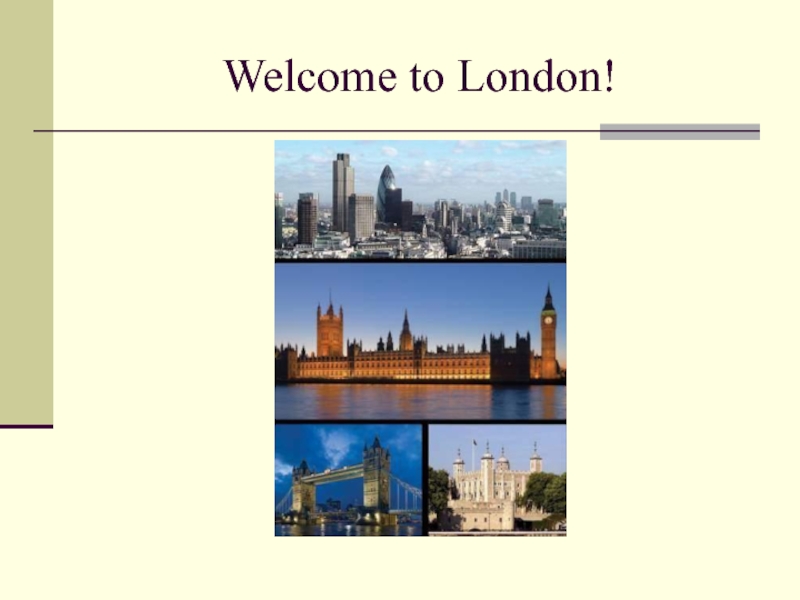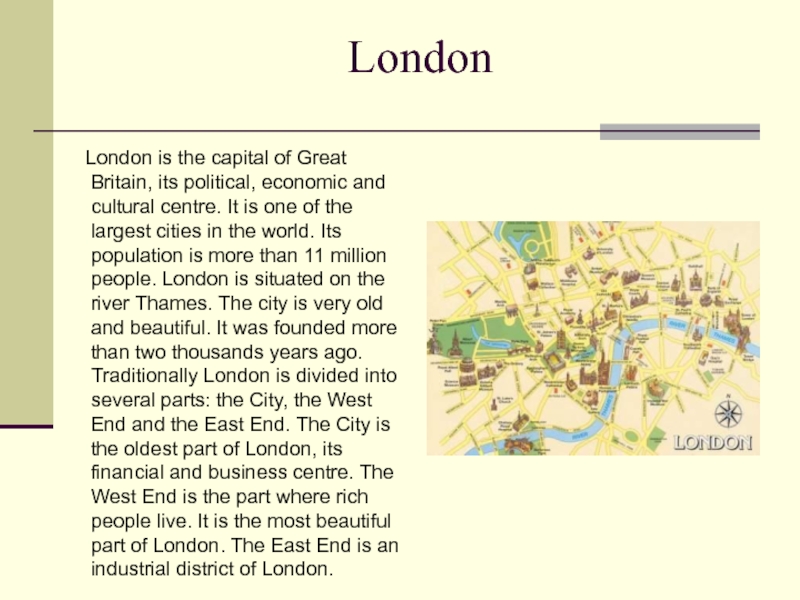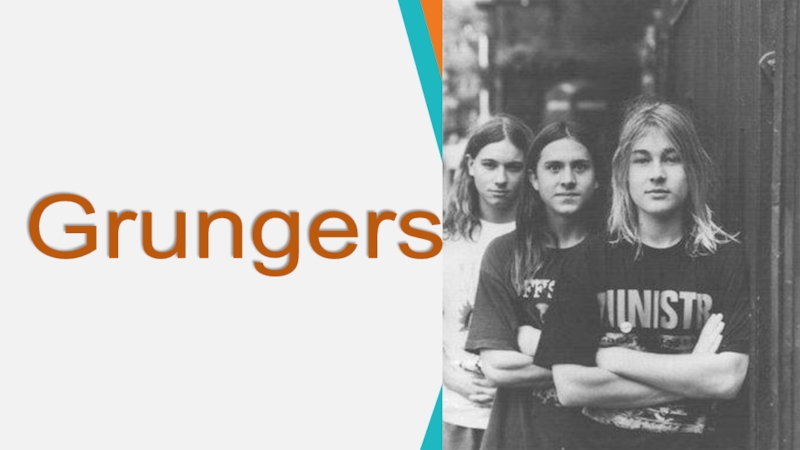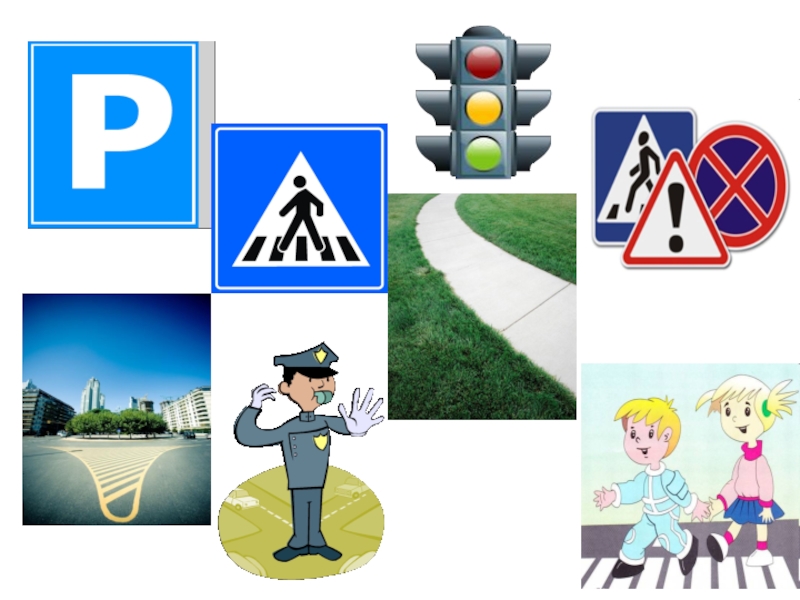Слайд 2London
London is the capital of Great Britain, its
political, economic and cultural centre. It is one of the
largest cities in the world. Its population is more than 11 million people. London is situated on the river Thames. The city is very old and beautiful. It was founded more than two thousands years ago. Traditionally London is divided into several parts: the City, the West End and the East End. The City is the oldest part of London, its financial and business centre. The West End is the part where rich people live. It is the most beautiful part of London. The East End is an industrial district of London.
Слайд 3Tower of London
It was founded by William
the Conqueror as a Royal Residence. It has been a
citadel, royal palace, seat of government and also the scene of some of the bloodiest events in English history. Kings, queens, princes and people of the highest rank were tortured, beheaded, murdered or imprisoned. The White tower contains a collection of arms and armour, including even a suit of armour made for an elephant. The Tower is also the nation’s treasure house, containing the Crown Jewels. Ceremonial is still part of the daily life within the Tower. Each night the Chief Warder locks the gates at 9.30 p.m. and presents the keys to the President Governer – a ritual that has taken place for 700 years. Yeoman warders still wear the distinctive colourful uniform that dates from Tudor times.
Слайд 4Tower Bridge
The most famous of London’s bridges is
the Tower Bridge. Twin Gothic-style towers are connected by a
walkway 142 feet above the water level. Tower Bridge is the only Thames bridge which can be raised. The road over the bridge is built on two central sections, they open two or three times a week to let ships through. Up the bridge there are walkways with good views of London.
Слайд 5Westminster Abbey
Westminster is a fine Gothic building. It
is founded in 1049. Westminster Abbey is the crowning place
of British monarchs. Kings and queens (except 2) have been crowned here since 1050. The Abbey contains the tombs and memorials of many famous English scientists. It has its poet’s corner, where many writers are buried.
Слайд 6Houses of Parliament
This Gothic-style building on the
banks of the river Thames is where laws governing British
life are formulated, debated and passed. At the opposite corner of the building rises the Victoria Tower, the largest and tallest square tower in the world. The flag over it shows that the Parliament is on work. The monarch is not allowed into the House of Commons. At the start of each session the queen goes to the House of Lords, sits on a throne and sends her representative, Black Rod, to knock on the door of the Commons to ask 650 members if they will go and listen to her speech. In front of the monarch’s throne is the Woolsack. This is the seat of the Lord Chancellor when the House is sitting.
Слайд 7Big Ben
On the best known landmarks in
the world is the Clock Tower Big Ben. This name
is given to the bell in the Clock Tower on which the hours are struck. The name commemorates Sir Benjamin Hall who was Commissioner of Works when the bell was cast. The bell weighs 13 ½ tons, the four clock faces each have a diameter of 22 ½ feet, the hour hands are 9 feet and the minute hands are 14 feet long. The height of the Clock Tower is 316 feet and a light shines from above the clock when the House is in session at night.
Слайд 8Buckingham Palace
It is the best-known palace in
the world. The first floor balcony is the scene of
formal appearances of the royal family on important occasions. Below it in the forecourt the colourful ceremony of Changing the Guards takes place daily. The interior of the palace is never opened to the public. The state rooms are used to receive visiting heads of state and for ceremonies. At the gates of Palace you can see London’s Town Crier. He wears an early 19th century style costume, carries a bell and owns a loud, commanding voice. His duty, on important national occasions, is to proclaim news.
Слайд 9Trafalgar Square
Trafalgar Square is a popular place
for political demonstrations and pigeons. The Square was laid out
in 1840 to commemorate the great naval victory of Britain in 1805 in which Admiral Lord nelson took part and was fatally wounded. In the center of the square there is a monument known as Nelson’s Column with the statue of Nelson at the top. Round the pedestal there are four bronze carvings representing Nelson’s famous naval victories. At the base there are four great lions. Every Christmas a fir tree is set up in Trafalgar Square, a gift from the people of Norway in thanks for the hospitality shown by the British nation to their Royal Family during World War II.
Слайд 10St. Paul’s Cathedral
It is a masterpiece
of Sir Christopher Wren, England’s great architect. The cathedral was
built between 1675 and 1710. St. Paul’s has been the setting for solemn and significant occasions in the nation’s history. You can see the huge dome with a golden ball and cross on the top. There are two towers, the north one contains 12 bells, the south – the clock and Great Paul, the largest bell in England. The dome is the second largest in the world. St. Paul’s contains monuments to the nation’s heroes. The inside of the Cathedral is very beautiful. You can climb 263 steps and get into the Whispering Gallery. It is called so because if someone whispers close to the wall on one side, a person on the other side can hear what is said. Then if you climb another 118 steps you will be able to look all over London. There are steps up to the golden ball.





























